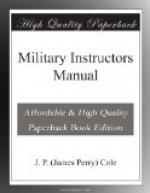When the soldier has become proficient in taking the proper position the exercise is conducted “At Will.”
QUICK FIRE.—Being at the Raise Pistol, chamber and magazine empty, 1. Quick Fire Exercise, 2. One. Lower the forearm until it is nearly horizontal, pistol pointing at the target, 3. Two. Thrust the pistol forward to the position of aim, snapping the pistol just before the arm reaches its full extension. Then look through sights to verify the pointing. 4. Three. Return to Raise Pistol and cock the pistol.
In this exercise the soldier must keep his eyes fixed upon the mark. He should constantly practice pointing the pistol until he acquires the ability to direct it on the mark in the briefest interval of time and practically without the aid of the sights. In other words, the pistol in this exercise is accurately pointed instead of accurately aimed. In night firing pointing the pistol is the only method that can be used. After careful practice in this exercise it is surprising what good results can be obtained at night.
This exercise should then be practiced from the position of the pistol in the holster instead of Raise Pistol.
CLASSES OF FIRE: 1. SLOW FIRE.—As described above. Target L or A or improvised target.
2. QUICK FIRE.—Being at Raise Pistol, pistols locked, at the command “Commence Firing” fire and return to Raise Pistol after each shot following the principles of Quick Fire Exercise. Target E, five yards apart, one for each man firing. This firing should be done by the numbers as described in Quick Fire Exercise.
3. AUTOMATIC FIRE (TARGET E).—Being at Raise Pistol, pistols locked. At the command “Commence Firing” empty the magazine in seven seconds, keeping the arm extended. Target E, 5 yards apart, one for each man firing.
4. TRENCH FIRE (TARGET E).—Two lines of targets. The first line is composed of F targets, 5 yards apart, one figure for each man firing. The second line is composed of two E figures, one yard apart, for each man firing, placed in a trench immediately in rear of the figures of the first line. This gives for each firer a group of three figures, one placed on top at the near edge of the trench and the other two in the trench immediately in rear. In case a trench is not available the rifle pit can be used. A gutter, sunken road, embankment, or hedge can be used for this purpose so long as trench fire is simulated.
[Illustration: Plate #5. TRENCH TARGET COURSE FOR THE AUTOMATIC PISTOL.]
The firing line advances at a walk from 100 yards takes up a double time 50 yards from trench, fires one shot at the double time when within ten yards of the first target continues to the trench and fires the remaining six shots, automatic fire, at the two targets in the trench in rear of the first line target.
SCORE (TARGET E, BOBBING).—A score will be seven shots. Targets will be marked after the men in the firing line have completed their scores. All loading and firing should be done by command.




